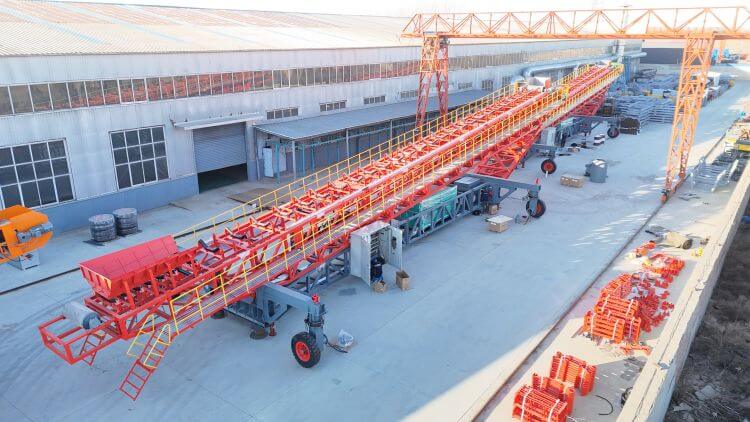Mobile stackers are self-propelled bulk material stacking equipment that use belt conveyor systems to quickly pile or transfer materials (such as coal, ore, grain, sand, etc.) to designated areas. Compared to traditional fixed stackers, their greatest advantages are high flexibility, rapid deployment, and adaptability to complex working conditions, making them particularly suitable for customers who frequently need to adjust their operational scenarios.

Components of Mobile Stacking Equipment
A mobile stacker is not a single device but an integrated system, with core modules including:
- Travel Mechanism: Equipped with either crawler or wheeled chassis, enabling autonomous movement and adaptation to complex terrain.
- Conveyor System: Composed of drive pulleys, idlers, and belts, responsible for material transport and stacking.
- Lifting and Slewing Device: Hydraulic or electric-driven, adjusting stacking height (up to 15 meters) and rotation angle (0°–360°).
- Power Unit: Diesel engine or electric motor, providing power (50–300 kW range).
- Intelligent Control Box: Integrates PLC, sensors, and remote monitoring interfaces for automated operation.
Features of Mobile Stackers
High Flexibility
- No Fixed Foundation Required: Mobile stackers use crawler or wheeled chassis, eliminating the need for pre-installed tracks or concrete foundations, and can move flexibly on soft ground, slopes, or temporary work areas.
- Multi-Angle Operation: Through hydraulic lifting and slewing systems, the equipment can achieve 360° rotation and pitch angle adjustment to meet various stacking height and shape requirements.
- Rapid Relocation: For example, Zoomry's ZR-SL series mobile stackers feature modular designs that enable quick disassembly and assembly, reducing relocation time by over 60% compared to traditional equipment.
High Efficiency
- Continuous Operation Capability: The equipment seamlessly connects with upstream conveyors (such as belt conveyors, telescopic stackers, or truck unloaders), enabling uninterrupted material handling from unloading to stacking, avoiding downtime.
- Intelligent Control System: Equipped with PLC and IoT technology, users can monitor stacking height, equipment status, fault alerts, and other parameters in real-time via remote terminals, reducing manual intervention.
- Precision Stacking: Using laser scanning or radar ranging technology, the equipment can automatically plan stacking paths to prevent material spillage or pile collapse.
Cost-Effectiveness
- Lower Initial Investment: Eliminates the need for civil engineering and track installation costs associated with fixed equipment, making it ideal for small and medium-sized enterprises with limited budgets.
- Energy Savings: Equipped with variable frequency drive technology, dynamically adjusting motor power based on load, reducing energy consumption by 15%–20% compared to traditional equipment.
- Easy Maintenance: Key components (such as idlers and pulleys) feature standardized designs for quick replacement, minimizing downtime losses.
Typical Applications of Mobile Stackers
Ports and Logistics Hubs
In modern bulk cargo terminals, the ZRSL series mobile shiploaders and ZRLS-TU series mobile truck unloaders form an efficient operational combination. The truck unloader's dual-slope unloading platform accommodates 30–60-ton trucks, achieving millimeter-level alignment with truck compartments via hydraulic lifting. Paired with a 1400mm-wide spill-proof Conveyor Belt, it ensures dust-free unloading of coal, iron ore, and other bulk materials at 1800 tons/hour. After temporary storage in trapezoidal piles formed by the mobile stacker, materials are precisely loaded by the shiploader's four-degree-of-freedom slewing mechanism. Its Coriolis mass flow meter monitors loading rates in real-time, while laser scanning creates 3D models of ship holds, controlling loading uniformity deviation within 0.5%, eliminating stability risks caused by uneven loading.
Mines and Quarries
For open-pit mines with continuously shifting extraction faces, the ZR160SF crawler mobile stacker with reinforced chassis is ideal. Its ground pressure of <80 kPa allows stable movement on 30° slopes, while its X-frame structure enhances torsional strength to 850 kN·m, withstanding impact loads from blasted ore. The intelligent stacking system uses millimeter-wave radar to scan pile contours, automatically adjusting boom pitch and rotation speed to form standardized piles with 60° natural repose angles for granite, copper ore, etc., increasing loader efficiency by over 40%.
Power Plants and Building Material Factories
Coal-fired power plants and cement plants favor the ZR100SF wheeled mobile stacker for its efficiency and flexibility. Its high-temperature-resistant conveyor belt operates continuously at 120°C, while the six-section telescopic boom achieves precise positioning within a 32-meter span via hydraulic synchronization. In cement clinker yards, its closed-loop control system integrates with central DCS, automatically adjusting stacking height and shape based on kiln production rhythms, maintaining buffer inventory at 8–12 hours of capacity to prevent efficiency losses in precalciner systems.
Emergency and Temporary Projects
For flood control, earthquake relief, and other emergencies, modular mobile stacking systems excel. Crawler models can deploy globally within 72 hours, with foldable structures conforming to standard transport dimensions (4.2m × 2.5m), becoming operational within 4 hours on-site. When handling construction debris, the vibrating feeder and dual-layer screening device separate concrete fragments from rebar at 800 m³/day, 20 times faster than manual sorting. Explosion-proof electrical systems and IP67 rating ensure reliable operation in rain, dust, and other harsh conditions.
Zoomry's Competitive Advantages
Customized Design and Rapid Delivery
- Offers "one project, one solution" services, supporting customization of length, belt width, power, and other parameters.
- Leverages a global supply chain, reducing standard equipment delivery time to 45 days, with priority production for urgent orders.
High Reliability Assurance
- Critical components (e.g., scraper blades, pulley bearings) use imported materials from Germany and Japan, extending service life to over 20,000 hours.
- Complies with ISO 9001, CE, ATEX (explosion-proof certification), and other international standards, suitable for extreme environments (high heat, humidity, dust).
Full Lifecycle Services
- Provides remote diagnostics, spare parts pre-stocking, and localized maintenance teams to ensure stable operation for overseas clients.

 ZOOMRY
ZOOMRY

